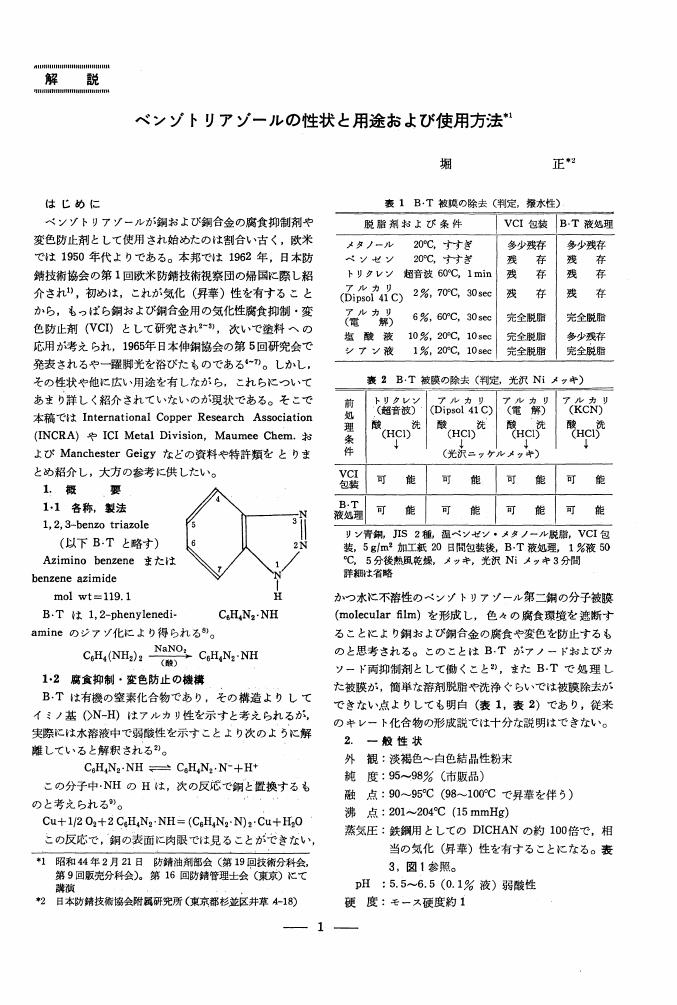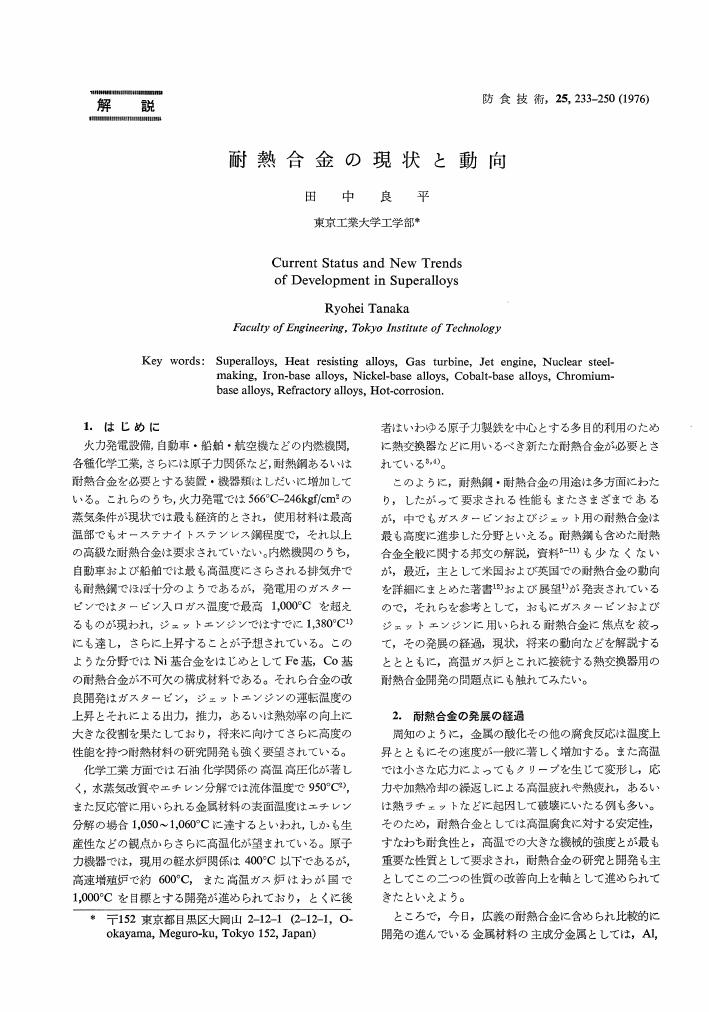13 0 0 0 OA 有機酸中におけるステンレス鋼の腐食
- 著者
- 滝沢 貴久男
- 出版者
- Japan Society of Corrosion Engineering
- 雑誌
- 防食技術 (ISSN:00109355)
- 巻号頁・発行日
- vol.36, no.2, pp.96-104, 1987-02-15 (Released:2009-10-30)
- 参考文献数
- 45
- 被引用文献数
- 1 1
This review describes the effects of environmental and metallurgical factors on the corrosion behaviour of stainless steel in organic acids as a food additive. That is to say, it gives an outline of the corrosive action of organic acids on the stainless steel and the relationship between metallurgical factors such as nonmetallic inclusions and alloying elements and corrosion resistance.
6 0 0 0 OA ステンレス鋼の硫化物応力腐食割れ
- 著者
- 宇都 善満
- 出版者
- 社団法人 腐食防食協会
- 雑誌
- 防蝕技術 (ISSN:00109355)
- 巻号頁・発行日
- vol.19, no.3, pp.117-125, 1970-03-15 (Released:2009-11-25)
- 参考文献数
- 13
- 被引用文献数
- 1
4 0 0 0 OA アルコール燃料の自動車への利用と技術課題
- 著者
- 金 栄吉
- 出版者
- Japan Society of Corrosion Engineering
- 雑誌
- 防食技術 (ISSN:00109355)
- 巻号頁・発行日
- vol.35, no.7, pp.413-420, 1986-07-15 (Released:2009-10-30)
- 参考文献数
- 7
- 被引用文献数
- 2 1
3 0 0 0 OA バクテリア腐食における硫酸塩還元
- 著者
- Gerald A. Trautenberg 荒牧 国次
- 出版者
- Japan Society of Corrosion Engineering
- 雑誌
- 防蝕技術 (ISSN:00109355)
- 巻号頁・発行日
- vol.13, no.8, pp.367-370, 1964-08-15 (Released:2009-11-25)
- 参考文献数
- 33
3 0 0 0 OA 金属および合金の一酸化窒素による高温酸化
- 著者
- 高須 芳雄 松田 好晴
- 出版者
- Japan Society of Corrosion Engineering
- 雑誌
- 防食技術 (ISSN:00109355)
- 巻号頁・発行日
- vol.31, no.3, pp.148-155, 1982-03-15 (Released:2009-10-30)
- 参考文献数
- 26
- 被引用文献数
- 1 1
Oxidation behaviors of Fe, Co, Ni, Cu, and four Ni-Cu alloys (81, 64, 42, and 21% Ni) have been studied in 10 Torr (exceptionally, 1×10-3 Torr) of NO at the elevated temperatures from 580-780°C. The oxidation behaviors of such metals and alloys have been examined also in O2 at the same pressures and temperatures for comparison. Various methods such as microgravimetry, X-ray diffractometry, X-ray photoelectron spectroscopy, Auger electron spectroscopy, and Ion micro analysis were adopted for this investigation. The results obtained are summarized as follows: (1) The oxidation of Fe and Co in NO obeyed the cubic and the parabolic rate laws, respectively; while those of Ni and Cu obeyed the linear rate law. The oxidation characteristics (rate, rate law, or activation energy) of these metals in NO were much different from those in O2. (2) Nickel was rapidly oxidized in NO accompanied with the expansion of samples which was caused by the preferential oxidation of grain boundary. (3) The oxidation of Cu in NO was rate-determined by the dissociation of NO on the oxide surface. (4) The oxide formed on Fe, Co, Ni, and Cu in NO were Fe3O4, CoO, NiO, and Cu2O, respectively; while in O2 were Fe3O4 and Fe2O3, CoO, NiO, and Cu2O, respectively. (5) In the oxidation of Ni-Cu alloy system in NO, an accelerating oxidation was observed for Ni-rich alloys. The total amount of oxygen uptake of the Ni-rich alloy was greater than those of the Cu-rich alloys after the accelerating oxidation in NO occurred. (6) The selective oxidation characteristics for Ni-Cu alloy system during the oxidation in NO was also different from those in O2. In the former case, preferential oxidation of Ni occurred, resulting in the formation of NiO-rich oxide layer on the alloy. For the Ni-rich alloy and copper was scarcely oxidized forming only a small amount of Cu2O in the outer layer. As has generally been reported, the oxide film on Ni-Cu alloy formed in O2 consisted of two distinct layers; i. e. the component of the outer layer was copper oxide (mainly CuO) and the inner was NiO.
3 0 0 0 OA 防食技術研究討論会 第3部門 電気防食
- 著者
- 重野 隼太
- 出版者
- 社団法人 腐食防食協会
- 雑誌
- 防蝕技術 (ISSN:00109355)
- 巻号頁・発行日
- vol.7, no.4, pp.187-193, 1958-07-15 (Released:2009-11-25)
2 0 0 0 OA 水道水による腐食
- 著者
- 門井 守夫
- 出版者
- 社団法人 腐食防食協会
- 雑誌
- 防蝕技術 (ISSN:00109355)
- 巻号頁・発行日
- vol.21, no.2, pp.51-61, 1972-02-15 (Released:2009-11-25)
- 参考文献数
- 15
- 被引用文献数
- 2
2 0 0 0 OA 高濃度硫酸中におけるステンレス鋼の腐食機構解析
- 著者
- 松橋 亮 安保 秀雄 阿部 征三郎 紀平 寛
- 出版者
- Japan Society of Corrosion Engineering
- 雑誌
- 防食技術 (ISSN:00109355)
- 巻号頁・発行日
- vol.36, no.9, pp.578-585, 1987-09-15 (Released:2009-10-30)
- 参考文献数
- 7
- 被引用文献数
- 5 8
The mechanism of corrosion of stainless steels in highly concentrated sulfuric acid was studied by the electrochemical method and surface analysis as EPMA and Laser-Raman Spectroscopy. Cyclic potential changes occured in this system about between -0.2V (SCE) (active state) and 0.2V (SCE) (passive state). The anodic reaction was determined as the metal dissolution in both the active and the passive state. The cathodic reaction in the active state near -0.2V (SCE) was mainly dominated by the reduction of hydrogen ion which was clearly indicated by the evolution of hydrogen gas. On the other hand, catholic reaction at the passive state about 0.2V (SCE) was determined as the reduction of molecular sulfuric acid resulting in the formation of sulfur and water. By the analysis of EPMA, precipitated sulfur was found on the specimen surface polarized at 0.2V (SCE) potentiostatically. The in-situ observation of corroding surface by Laser-Raman spectroscopy indicated the formation of precipitated sulfur on the metal surface at the corrosion potential. Cyclic changes in corrosion potentials were considered due to the following mechanisms; dissolved metal ion at the active state formed metal sulfate films on the metal surface, leading the corrosion potential to the passive state. Inversely at the passive state, water as the product of the cathodic reaction accelerated the dissolution of the metal sulfate film to move the corrosion potential to the active state.
2 0 0 0 OA 金属美術・工芸品の表面処理
- 著者
- 小口 八郎
- 出版者
- Japan Society of Corrosion Engineering
- 雑誌
- 防食技術 (ISSN:00109355)
- 巻号頁・発行日
- vol.32, no.2, pp.104-113, 1983-02-15 (Released:2009-10-30)
- 参考文献数
- 25
Materials and techniques used in Japanese traditional metal arts and crafts were examined from the standpoint of modern science. Surface finishings reviewed are;(1) Polishing, (2) Roughening or Patterning of metal surface, (3) Fire-gilding with gold amalgam, (4) Coloring.It is concluded that Japanese traditional techniques in metals arts are excellent in ornamenting the metal articles and even suggest some ideas that are applicable to modern technology.
2 0 0 0 OA 軽合金の微生物腐食
- 著者
- 井上 真由美
- 出版者
- 社団法人 腐食防食協会
- 雑誌
- 防蝕技術 (ISSN:00109355)
- 巻号頁・発行日
- vol.16, no.11, pp.453-462, 1967-11-15 (Released:2009-11-25)
- 参考文献数
- 22
2 0 0 0 OA 酸化皮膜の機械的性質と金属の酸化
- 著者
- 本間 禎一
- 出版者
- Japan Society of Corrosion Engineering
- 雑誌
- 防食技術 (ISSN:00109355)
- 巻号頁・発行日
- vol.25, no.4, pp.251-265, 1976-04-15 (Released:2009-10-30)
- 参考文献数
- 62
- 被引用文献数
- 13 4
This review makes a survey on that the behaviors and the mechanisms proposed of both the stress generation in oxide films and the plastic deformations of oxides at high temperatures, and discusses a role of the mechanical properties of the oxide films in the oxidation of metals. It suggests that the kinetic studies of some oxidation reactions need to be examined again with the mechanical properties of the oxide included in the considerations.
2 0 0 0 OA ベンゾトリアゾールの性状と用途および使用方法
- 著者
- 堀 正
- 出版者
- 社団法人 腐食防食協会
- 雑誌
- 防蝕技術 (ISSN:00109355)
- 巻号頁・発行日
- vol.18, no.9, pp.393-398, 1969-09-15 (Released:2009-11-25)
- 参考文献数
- 65
- 被引用文献数
- 2 1
2 0 0 0 OA 耐熱合金の現状と動向
- 著者
- 田中 良平
- 出版者
- Japan Society of Corrosion Engineering
- 雑誌
- 防食技術 (ISSN:00109355)
- 巻号頁・発行日
- vol.25, no.4, pp.233-250, 1976-04-15 (Released:2009-10-30)
- 参考文献数
- 89
- 被引用文献数
- 3 1
2 0 0 0 OA 電極反応の平衡論と速度論
- 著者
- 馬場 宣良
- 出版者
- 社団法人 腐食防食協会
- 雑誌
- 防蝕技術 (ISSN:00109355)
- 巻号頁・発行日
- vol.18, no.8, pp.367-376, 1969-08-15 (Released:2009-11-25)
- 参考文献数
- 6
- 被引用文献数
- 1
1 0 0 0 OA 電気防食用整流器としてのセレンとシリコンの優劣 (抄訳)
- 著者
- D. P. Wilson 花田 政明
- 出版者
- Japan Society of Corrosion Engineering
- 雑誌
- 防蝕技術 (ISSN:00109355)
- 巻号頁・発行日
- vol.9, no.8, pp.365, 1960-08-25 (Released:2009-11-25)
1 0 0 0 OA 低酸素圧下における金属の酸化-測定技術を中心として-
- 著者
- 長阪 道雄
- 出版者
- Japan Society of Corrosion Engineering
- 雑誌
- 防食技術 (ISSN:00109355)
- 巻号頁・発行日
- vol.24, no.4, pp.193-204, 1975-04-15 (Released:2009-10-30)
- 参考文献数
- 55
- 被引用文献数
- 1 1
1 0 0 0 OA 英国海軍の船舶および構築物に対する電気防蝕の適用
- 著者
- 重野 隼太 J. T. Crennell
- 出版者
- Japan Society of Corrosion Engineering
- 雑誌
- 防蝕技術 (ISSN:00109355)
- 巻号頁・発行日
- vol.4, no.3, pp.117-122, 1955-06-05 (Released:2009-11-25)
1 0 0 0 OA 水道水腐食の基礎としての水質化学
- 著者
- 小玉 俊明 藤井 哲雄
- 出版者
- Japan Society of Corrosion Engineering
- 雑誌
- 防食技術 (ISSN:00109355)
- 巻号頁・発行日
- vol.26, no.11, pp.641-653, 1977-11-15 (Released:2009-10-30)
- 参考文献数
- 39
- 被引用文献数
- 9 2
Chemical factors affecting the corrosion of plumbing materials in fresh waters are reviewed in this article. Detailed discussions are given for pH, alkalinity, dissolved oxygen, anions, water treatment, and calcium carbonate equilibria.
1 0 0 0 OA 鉄の腐食における塩素イオンの役割
- 著者
- R. T. Foley 上野 忠之
- 出版者
- Japan Society of Corrosion Engineering
- 雑誌
- 防蝕技術 (ISSN:00109355)
- 巻号頁・発行日
- vol.20, no.5, pp.227-239, 1971-05-15 (Released:2009-11-25)
- 参考文献数
- 81
- 被引用文献数
- 3 2
1 0 0 0 OA 大気汚染と金属腐食
- 著者
- 田尻 勝紀
- 出版者
- 社団法人 腐食防食協会
- 雑誌
- 防蝕技術 (ISSN:00109355)
- 巻号頁・発行日
- vol.13, no.5, pp.193-201, 1964-05-15 (Released:2009-11-25)
- 参考文献数
- 35













